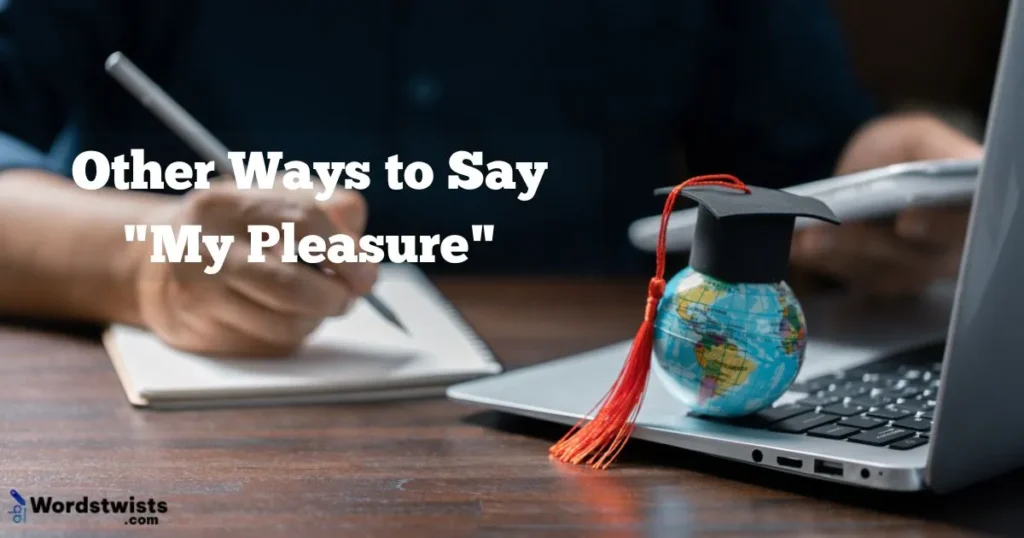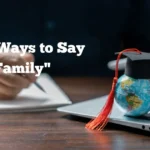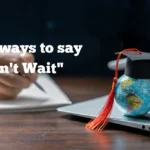Have you ever found yourself stuck saying “My pleasure” over and over again? It’s a common moment in everyday conversations—whether you’re at a bustling office, a cozy coffee shop, or chatting online with friends. That simple phrase is polite and friendly, but after a while, it can start to feel a bit dull and repetitive. If you’re like me, you want your words to truly shine and reflect your genuine warmth, kindness, and sincerity.
Whether you’re writing a heartfelt thank-you note to a colleague, responding to a compliment from a neighbor, or chatting with family members during a holiday gathering, finding creative alternatives can make your language more expressive and meaningful. This is especially important in today’s world, where effective communication and personal touch matter more than ever.
This post is here to help you break free from the common phrase and add fresh, vibrant flavor to your daily conversations. With these 25 powerful alternatives to “My pleasure,” you’ll be able to respond with confidence, charm, and personality. Each option is carefully chosen not just for variety but for its ability to fit naturally in everyday speech—whether you’re talking with your boss, a client in a corporate meeting, or friends at a local community center.
Ready to expand your vocabulary and make your communication sparkle? Dive in and discover new ways to say “My pleasure” that will boost your social skills, enhance your personal and professional relationships, and leave a lasting impression. Let’s make your words count and bring more warmth and authenticity into your interactions!
Alternatives to “My Pleasure”
1. Happy to help
This phrase is warm and approachable. It shows enthusiasm and willingness to assist without sounding formal or stiff. It’s great for casual conversations where you want to express friendliness.
Examples:
- “Thanks for your help!” — “Happy to help!”
- “Can you fix this for me?” — “Happy to help!”
- “I appreciate your time.” — “Happy to help anytime.”
- “Thanks for the advice.” — “Happy to help you out.”
- “I’m grateful for your support.” — “Happy to help whenever you need.”
Why it works:
It’s simple, friendly, and expresses genuine willingness, making your words sound heartfelt and natural.
2. Glad to assist
Slightly more formal than “Happy to help,” this phrase fits well in professional or polite settings. It conveys readiness to provide help with a positive tone.
Examples:
- “Could you review this document?” — “Glad to assist.”
- “Thanks for your support.” — “Glad to assist you anytime.”
- “I need some guidance here.” — “Glad to assist.”
- “Your help means a lot.” — “Glad to assist with pleasure.”
- “Thanks for being there.” — “Always glad to assist.”
Why it works:
It blends professionalism and warmth, making it perfect for work emails or polite chats.
3. It’s nothing
This casual phrase downplays the effort you made, showing humility and making the other person feel comfortable.
Examples:
- “Thank you for your help.” — “It’s nothing.”
- “I really appreciate it.” — “It’s nothing at all.”
- “Thanks for the favor.” — “It’s nothing, happy to do it.”
- “I owe you one.” — “It’s nothing, anytime.”
- “Thanks for coming through.” — “It’s nothing, glad to help.”
Why it works:
It’s humble and unpretentious, which makes your response feel natural and genuine.
4. You’re welcome
A classic response that fits every situation. It’s polite, clear, and always appropriate.
Examples:
- “Thank you so much.” — “You’re welcome.”
- “Thanks for your help.” — “You’re welcome.”
- “I appreciate it.” — “You’re very welcome.”
- “Thanks a lot.” — “You’re welcome.”
- “Thanks for everything.” — “You’re welcome, happy to help.”
Why it works:
It’s versatile and universally understood, making it a safe and sincere reply.
5. Anytime
This phrase offers openness to help again in the future. It feels casual and friendly, showing you’re approachable.
Examples:
- “Thanks for your help!” — “Anytime!”
- “I appreciate your support.” — “Anytime you need.”
- “Thanks a lot.” — “Anytime, happy to help.”
- “Thanks for the assist.” — “Anytime, just ask.”
- “I’m grateful.” — “Anytime, always here.”
Why it works:
It’s friendly and invites future connection, making your response feel warm and encouraging.
6. Don’t mention it
This phrase is light, friendly, and humble. It’s a way of saying, “It wasn’t a big deal,” while still acknowledging someone’s thanks.
Examples:
- “Thanks for your help moving.” — “Don’t mention it!”
- “I appreciate you picking me up.” — “Don’t mention it.”
- “Thanks a million.” — “Don’t mention it at all.”
- “Thanks for stepping in.” — “Don’t mention it, anytime.”
- “Thank you so much.” — “Don’t mention it, I’m happy to be there.”
Why it works:
This phrase shows you’re not seeking credit. It keeps the tone light, humble, and supportive without overdoing formality.
7. With pleasure
This is a direct and refined way to replace “My pleasure.” It sounds polished but still warm and genuine.
Examples:
- “Thanks for helping.” — “With pleasure.”
- “I appreciate your help.” — “With pleasure, truly.”
- “Thank you!” — “With pleasure.”
- “Thanks for attending.” — “With pleasure, always glad to join.”
- “I’m thankful for your support.” — “With pleasure, happy to help.”
Why it works:
It’s a graceful, professional-sounding reply that works in both personal and business conversations.
8. I’m delighted
This phrase expresses true happiness to be of help. It adds a touch of charm and personal warmth.
Examples:
- “Thanks for taking the time.” — “I’m delighted to assist.”
- “Thanks for everything!” — “I’m delighted I could help.”
- “I appreciate you doing that.” — “I’m delighted to do it.”
- “You really came through.” — “I’m delighted to support you.”
- “Thank you again.” — “I’m delighted to be there for you.”
Why it works:
Using the word “delighted” adds emotional richness and lets your listener feel that you truly enjoyed helping.
9. No problem
Casual, calm, and widely used, “No problem” is perfect for informal situations where you want to sound easygoing.
Examples:
- “Thanks for helping out!” — “No problem!”
- “I appreciate it.” — “No problem, anytime.”
- “Thanks a lot.” — “No problem, happy to help.”
- “You saved me.” — “No problem at all.”
- “I owe you one.” — “No problem, I got you.”
Why it works:
It makes the help feel effortless and keeps the tone relaxed and friendly.
10. Sure thing
This phrase adds a cheerful, enthusiastic tone to your response. It’s informal but upbeat and sounds confident.
Examples:
- “Thanks for jumping in.” — “Sure thing!”
- “I appreciate your support.” — “Sure thing, anytime.”
- “Thanks for the quick reply.” — “Sure thing!”
- “You really helped me out.” — “Sure thing, always here.”
- “Thanks again.” — “Sure thing, no worries.”
Why it works:
“Sure thing” sounds positive and reliable, which builds a friendly connection without sounding too formal.
11. At your service
This phrase has a classy tone. It’s often used in customer service or formal settings, but it can add a touch of humor or charm in personal conversations too.
Examples:
- “Thanks for helping so quickly.” — “At your service!”
- “I appreciate your time.” — “At your service, always.”
- “You were amazing.” — “At your service.”
- “Thanks for staying late.” — “At your service, anytime.”
- “Thanks, that was fast.” — “At your service, glad to do it.”
Why it works:
It adds professional elegance and shows that you’re available and dependable.
12. It’s my joy
This phrase goes beyond “my pleasure” and adds emotional sincerity. It tells the listener that you genuinely enjoyed helping.
Examples:
- “Thanks for your help.” — “It’s my joy.”
- “You’ve been so helpful.” — “It’s my joy to be of support.”
- “Thanks a ton.” — “It’s my joy, truly.”
- “I appreciate that.” — “It’s my joy to assist you.”
- “Thanks again.” — “It’s my joy to help however I can.”
Why it works:
It expresses authentic gratitude and adds a warm, personal connection to your reply.
13. Always happy to help
This phrase emphasizes your consistent willingness to assist. It sounds helpful, humble, and kind.
Examples:
- “Thanks for your guidance.” — “Always happy to help.”
- “Thanks a million.” — “Always happy to help.”
- “I appreciate your time.” — “Always happy to help, just ask.”
- “Thanks again.” — “Always happy to help!”
- “You’re a lifesaver.” — “Always happy to help you out.”
Why it works:
It signals reliability, generosity, and a positive attitude, all in one.
14. It was a pleasure
A slightly past-tense version of “My pleasure,” this one is great after completing a task or service. It sounds thoughtful and complete.
Examples:
- “Thanks for today.” — “It was a pleasure.”
- “I appreciate your help earlier.” — “It was a pleasure.”
- “Thanks for your support.” — “It was a pleasure to assist.”
- “Thanks again!” — “It was a pleasure helping.”
- “Great job.” — “It was a pleasure working with you.”
Why it works:
It wraps up the interaction with class and closure, while keeping the tone friendly and polished.
15. I’m here for you
This phrase adds a supportive, emotional layer to your message. It’s perfect when someone needs reassurance along with gratitude.
Examples:
- “Thanks for listening.” — “I’m here for you.”
- “You’ve been great.” — “I’m here for you, always.”
- “I appreciate your care.” — “I’m here for you anytime.”
- “Thanks for standing by me.” — “I’m here for you.”
- “You’re a true friend.” — “I’m always here for you.”
Why it works:
It delivers empathy and a sense of emotional connection, making it more than just a polite reply.
16. You got it
This phrase is casual and confident. It’s a fun, quick way to say “I’m happy to help” and shows you’re reliable.
Examples:
- “Thanks for helping me out.” — “You got it!”
- “Can you send me the report?” — “You got it.”
- “Thanks for the quick response.” — “You got it!”
- “I appreciate your support.” — “You got it, anytime.”
- “Thanks a lot!” — “You got it, happy to help.”
Why it works:
It sounds energetic, friendly, and gives a feeling of can-do attitude, making your communication lively and reassuring.
17. My delight
This phrase is a bit poetic and heartfelt. It shows that helping someone is truly a source of happiness for you.
Examples:
- “Thank you so much.” — “My delight.”
- “I appreciate all you did.” — “Helping you is my delight.”
- “Thanks for your time.” — “My delight, always.”
- “You’ve been amazing.” — “My delight to assist.”
- “Thanks again.” — “It’s truly my delight.”
Why it works:
It adds a touch of elegance and sincerity, showing that your pleasure in helping is genuine and deep.
18. I’m glad to be of service
This phrase is polite and respectful. It fits nicely in formal or professional contexts and conveys readiness to help.
Examples:
- “Thanks for your support.” — “I’m glad to be of service.”
- “I appreciate your help.” — “I’m glad to be of service anytime.”
- “Thank you for your time.” — “I’m glad to be of service.”
- “Thanks for the assistance.” — “I’m glad to be of service.”
- “I’m grateful.” — “I’m glad to be of service, happy to help.”
Why it works:
It sounds respectful and professional, emphasizing your commitment to assist with honor and care.
19. Of course
This short phrase is friendly and casual. It’s a simple way to say “You’re welcome” with a tone that says helping was obvious and natural.
Examples:
- “Thanks for your help.” — “Of course!”
- “I appreciate it.” — “Of course, no problem.”
- “Thanks a lot.” — “Of course!”
- “Thanks for that.” — “Of course, happy to help.”
- “I’m grateful.” — “Of course, anytime.”
Why it works:
It feels natural and warm, like saying “Absolutely, happy to do it!” without any fuss.
20. I’m happy to do it
This phrase clearly shows enthusiasm and joy in helping. It’s positive and expressive without being overly formal.
Examples:
- “Thanks for your assistance.” — “I’m happy to do it.”
- “I appreciate your support.” — “I’m happy to do it anytime.”
- “Thanks so much.” — “I’m happy to do it.”
- “Thanks for your help.” — “I’m happy to do it for you.”
- “Thanks again.” — “I’m happy to do it whenever you need.”
Why it works:
It communicates sincerity and a positive attitude, making your reply feel heartfelt and genuine.
21. No worries
This phrase is casual and reassuring. It’s great for everyday conversations when you want to show that helping was easy and stress-free.
Examples:
- “Thanks for your help.” — “No worries!”
- “I appreciate it.” — “No worries at all.”
- “Thanks a lot.” — “No worries, happy to help.”
- “Thanks for doing that.” — “No worries!”
- “I owe you.” — “No worries, anytime.”
Why it works:
It keeps the tone lighthearted and friendly, perfect for informal interactions.
22. It’s a pleasure to help
This phrase combines politeness with warmth. It shows you enjoy helping and want the other person to know it.
Examples:
- “Thanks for your assistance.” — “It’s a pleasure to help.”
- “I appreciate your support.” — “It’s a pleasure to help anytime.”
- “Thank you!” — “It’s a pleasure to help.”
- “Thanks a lot.” — “It’s a pleasure to help you.”
- “Thanks for your time.” — “It’s a pleasure to help.”
Why it works:
It’s expressive and respectful, making your appreciation of the opportunity to help very clear.
23. Always a pleasure
This phrase highlights your consistent joy in helping. It’s friendly and positive, making your willingness clear.
Examples:
- “Thanks for your help.” — “Always a pleasure!”
- “I appreciate it.” — “Always a pleasure to help.”
- “Thanks a lot.” — “Always a pleasure.”
- “Thanks for your support.” — “Always a pleasure.”
- “Thank you so much.” — “Always a pleasure!”
Why it works:
It conveys consistency and a cheerful spirit, helping your communication feel warm and ongoing.
24. Gladly
This short word is crisp and positive. It expresses willingness and happiness to help in a concise way.
Examples:
- “Thanks for your help.” — “Gladly!”
- “Can you do this?” — “Gladly.”
- “Thanks so much.” — “Gladly!”
- “I appreciate your support.” — “Gladly, happy to help.”
- “Thanks a lot.” — “Gladly!”
Why it works:
It’s direct and positive, making your willingness to help sound enthusiastic and clear.
25. That’s what I’m here for
This phrase adds a personal and reassuring touch. It shows your role is to support, making the other person feel valued.
Examples:
- “Thanks for your help.” — “That’s what I’m here for.”
- “I appreciate your support.” — “That’s what I’m here for.”
- “Thanks so much.” — “That’s what I’m here for, happy to help.”
- “You’re a great friend.” — “That’s what I’m here for.”
- “Thanks again.” — “That’s what I’m here for, anytime.”
Why it works:
It sounds supportive and reliable, emphasizing your role as someone they can count on.
Conclusion
Finding the perfect way to say “My pleasure” can transform ordinary conversations into memorable moments filled with warmth and personality. By using these 25 creative alternatives, you not only avoid sounding repetitive but also add a unique, authentic touch to your replies. Whether you want to sound casual, professional, or heartfelt, these phrases help you communicate with confidence and kindness.
Expanding your vocabulary with these expressions enhances your communication skills and makes your compliments and responses stand out with style. So next time someone thanks you, try one of these options to show your gratitude in a fresh and meaningful way. Your words will feel more genuine, making every interaction shine a little brighter.
Keep practicing these alternatives, and watch how your conversations grow more engaging and natural. Remember, a simple phrase can make a big difference—choose yours with care and let your personality shine through!

I’m Leo Knox, the wordplay wizard behind WordsTwists.com where I turn everyday meanings into funny, clever, and creative twists. If you’re tired of saying things the boring way, I’ve got a better (and funnier) one for you!


